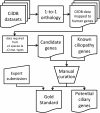The SYSCILIA gold standard (SCGSv1) of known ciliary components and its applications within a systems biology consortium
- PMID: 23725226
- PMCID: PMC3674929
- DOI: 10.1186/2046-2530-2-7
The SYSCILIA gold standard (SCGSv1) of known ciliary components and its applications within a systems biology consortium
Abstract
The multinational SYSCILIA consortium aims to gain a mechanistic understanding of the cilium. We utilize multiple parallel high-throughput (HTP) initiatives to develop predictive models of relationships between complex genotypes and variable phenotypes of ciliopathies. The models generated are only as good as the wet laboratory data fed into them. It is therefore essential to orchestrate a well-annotated and high-confidence dataset to be able to assess the quality of any HTP dataset. Here, we present the inaugural SYSCILIA gold standard of known ciliary components as a public resource.
Figures


References
-
- von Mering C, Krause R, Snel B, Cornell M, Oliver SG, Fields S, Bork P. Comparative assessment of large-scale data sets of protein-protein interactions. Nature. 2002;417:399–403. - PubMed
-
- Blacque OE, Perens EA, Boroevich KA, Inglis PN, Li C, Warner A, Khattra J, Holt RA, Ou G, Mah AK, McKay SJ, Huang P, Swoboda P, Jones SJM, Marra MA, Baillie DL, Moerman DG, Shaham S, Leroux MR. Functional genomics of the cilium, a sensory organelle. Curr Biol. 2005;15:935–941. doi: 10.1016/j.cub.2005.04.059. - DOI - PubMed
-
- Chen N, Mah A, Blacque OE, Chu J, Phgora K, Bakhoum MW, Newbury CRH, Khattra J, Chan S, Go A, Efimenko E, Johnsen R, Phirke P, Swoboda P, Marra M, Moerman DG, Leroux MR, Baillie DL, Stein LD. Identification of ciliary and ciliopathy genes in Caenorhabditiselegans through comparative genomics. Genome Biol. 2006;7:R126. doi: 10.1186/gb-2006-7-12-r126. - DOI - PMC - PubMed
Grants and funding
LinkOut - more resources
Full Text Sources
Other Literature Sources

